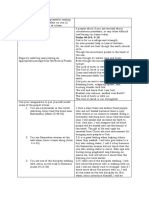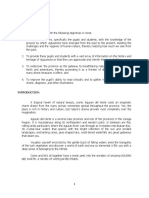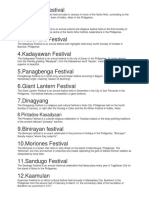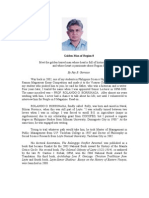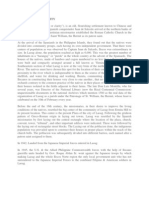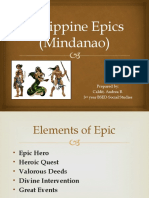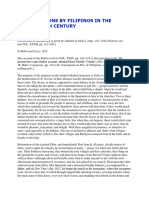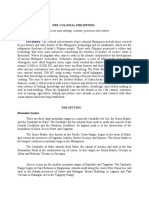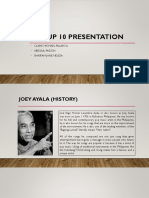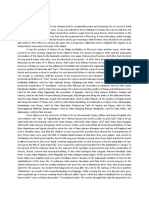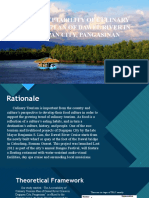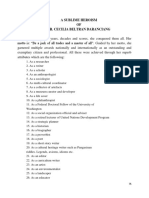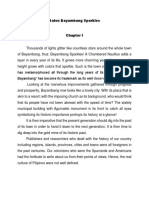Mangatarem, the Giant Pearl of Pangasinan
Look back, look back! Mangatarem folk, look back, look back!
Look up, look up! Mangatarem folk, look up, look up!
Now is the time to bring back the town’s beauty and elegance.
Listen to the story
Of our town’s glory and beauty.
It is an opportune time to open the giant shell that has hidden pearl that
reveals the brilliance that has been kept in silence for thousands of years.
The facade of Mangatarem’s magnificence will now shine in the pedestal of
time.
The lofty top of Nagboquel Mountain is standing like a queen in
southwestern part of the town. Its name is derived from its almost perfect
cone on its top contesting Mayon Volcano. It soars by the side of Manlelwag
hot springs that welcome visitors and tourists for its warm waters that mix
with sulfur which contains medicinal effects. One pool is for adults as large
an Olympic pool. The other is almost half the size intended for children.
The western part of the town is lined by the Zambales Mountain
Ranges that adorned the town’s western boundaries. Long time ago, every
morning when Aurora was still beaming in the eastern skies, my sisters and
I used to lead our childish steps to barrio Pogonlomboy which settled about
half kilometer away from our house. We fell in line along the edge of the
stony and dusty road which laced along open rice fields. Such a perfect stage
�to view the dark blue mountains that sent their songs of delight and gratitude
for our appreciation.
How wonderfully nature paints its portraits of admirable luxury.
Everywhere you turn your heads to nature’s brush roll over green branches,
over green grass that yields red, yellow, orange and violet flowers that send
scents of perfumes to your nostrils.
Four kilometers from the town lies barrio Talogtog which offers its walk
side by side with a creek that flows down from Suaco brook deep enough for
swimming practice. There was abundance of fish like alalo, gurami, dalag,
pantat, siwi-siwi, coros, ayungin and igat. Their abundance sends you to
jump and shout for joy. Along the sides of the brook it was fun to turn stones
upside down where the fish used to hide but ready to offer themselves for
lunch.
Going northward about a kilometer long lies the Olo River with its deep
blue and clear water. Because of its size, it offered more flood for the
sustenance for its residents. It lodged more fish by multiplication than the
Talogtogan-Suaco Brook. It was filled also by snails such as bisokol, alireg,
dukiang, birabid and dacomo. Water weeds like baliba, bilbilwak and
pakpako flourished. Along its banks grew tree vegies of potot, baeg, caturay,
malungay and carolis.
Going up west lie two rivers that supply water, fish, water weeds and
bank vegie trees to Olo River. Such twin rivers are named Tagac River and
Naguilayan River that formed Letter Y in form. Going one kilometer closer to
town beckons Bueno River. Its source is about two kilometers west where a
lagoon like is harbored with boulder-like stones polished and rounded like
purpose hewn to give the cove harmony with its silent water. How
magnificent a water garden nature has prepared for its inhabitants!
� Along its banks, greeneries abound. Along the dripping waters that go
down the Bueno River are gardens of water cress that compete with bal-liba.
In addition, along the banks are lined with dark green banasi interspersed
with banaba trees that are completely covered with lavender blossoms when
in bloom. What a perfect scenery to enjoy! Such a fabulous cove in named
Pila because frequently people great in numbers cannot be contained by the
natural resort so that men, women had to form lines termed pila in the dialect,
to wait for their turns.
Only half of a kilometer from the town plaza lies Pogonlomboy Creek,
a tributary of Caviernisan River coming from the Pacalat Dam that nature
has hewn to provide water for the whole town of Mangatarem. It also has
provided a natural swimming pool that attract so many nature lovers.
Pogonlomboy Creek is paired by its twin Boris Brook. In the local
dialect, boris means watery feces. People thought that such term was coined
to depict the usual practice of some who defect as they bathe in the brook.
But the truth of it is that it is named after an American Engineer Borris who
built the first bridge across. Originally, only two coconut trunks served as
bridge so that all types of vehicles had to take a detour to reach
Pogonlomboy from Embarkadero. Caoile Street was formerly named
Embarkadero because embarkation from Dorongan served the purpose. In
the old days riverine communities laced the country.
According to my maternal grandmother whom we all called Bai Laleng
(Eulalia Duque Sison) only tiangues, tagantanan-gues, and baleyangues
existed in the middle of the town. There was no market place yet. The church
and the plaza began to be developed only in the 1850’s wherein the
developments took decades to complete through forced labor. As a proof to
this, she took herself as an example. She was born on January 6, 1864.
�When she was ten years old, she was among the group of children who were
forced to carry limestone bricks from barrio Sapang. Such bricks were used
for the walls of the church. Because Sapang was the source of limestone
bricks which were called serial the barrio derived its Nanserialan name in
1820s. In actuality, limestones were not the only kind of natural stones in
Sapang. There are also jade bricks called pedra China, jade pebbles and
volcanic stones. The jade bricks were used for the church floor which are
gone now for they were replaced by tiles.
Both the church and the plaza were designed by the Spanish
conquerors wherein a pattern was similar in all towns occupied by Spanish
authorities in the whole country. But the pattern of Municipal and School
Buildings were created by the Americans. For such, Gabaldon Buildings are
found in all towns of the Philippines.
In Mangatarem Central School for Elementary Education lies north of
the town plaza. Both the plaza and the school ground look equal in area.
Each has four hectares. The Mangatarem Plaza has the biggest area in the
whole province of Pangasinan. In the 1960’s and 1970’s, it was the star of
all plazas in the province because of its beautiful landscape.
Going southwest from Mabini Street is Barangay Caviernisan. At the
western tip lies Pacalat, considered the natural resort because of its huge
amiable river rich in stones that has been stored by centuries if not millions
of years. But destruction has begun due to quarrying that some people have
filled their pockets proud to become millionaires.
At the northwestern part walking Maravilla Street, you reach Barangay
Parian. Its name came from its Tiangue or market which served people from
the barangays at the northern tips. Although its location is not too far from
the town proper, people preferred to establish Parian as their trading center
�due to difficulty of travel. In the earlier times, there were few roads where
vehicles could pass through. Most barangays could be reached only by
walking along footpaths. During rainy season, the footpaths which were
common to all barrios become muddy due to floods. In addition to this,
people from neighboring communities knew one another where trust was
fostered. Trust was needed because in times of old, trading was through
tagantan and utang (barter and lending). The trading centers in the southern
barangay took place in Macarang, Baracbac, Andargin, Bogtong and Olo.
Further west from Parian lie a cluster of barrios Bantocaling, Buenlag,
Bantay and Marapudo. Coming from Umangan, you reach Ponglon Muelag
where further west lies Ponglo Baleg. Ponglo Muelag means small hill while
Ponglo Baleg means large hill. Marapudo has raised the flag of history not
only for Mangatarem but also for many towns of Pangasinan. It was an old
seat of history.
Barangay Marapudo was occupied by Aeta tribes that traveled from
Bataan along the Zambales Mountain slopes. The Aetas are nomadic people
but found the site of Marapudo as their ideal settlement. Their leader, named
King Marapudo was named after bolo, a certain kind of bamboo that
flourished abundantly in such a place. Although there were other types of
bamboo in the place, the bolo type beat them all. In Aeta language thousands
of years ago, pudo was the term used for bolo. Hence, their king was named
Ari Marapudo which means king that owns wealth of bolo bamboos that
thrived with rattan in the huge mountain village that history marked its
destiny.
When I was young, a man and his family lived four houses away across
the street from my parents’ house where they and my siblings lived. The
above mentioned former family made a living by hunting wild life such as
�deer (usa), wild pig (alingo), wild chicken (abuyo), pagong (turtle), tilay
(lizard), bakes (monkey for pets), igat (huge eels), mantekyab (birds) and
kaging (bats). For such an accupation, Aetas who were experts in such trade
were taken as slaves. Mr. Calip was the man who owned them numbering
about a hundred. Mr. Calip owned a big wooden house that was filled with
Aetas when he brought them to town. The wooden house was a type of stilt
house. The host of Aetas lived in packs under stilt house.
The Aetas learned to speak Ilocano so that I was able to gather much
information from them as I played with Nena and Mimi, the daughters of Mr.
Calip. I heaped so much information for said Aetas especially their exploits
in discovering many towns of Pangasinan from west to east.
Before going to other places of Pangasinan, I find it easier to describe
the Aetas’ Exploration in Mangatarem first as they helped shape the town’s
history.
Be of good cheer my fellow men of my beloved town of Mangatarem
for your renowned event forth among the heathen for its natural beauty in
the past and its original perfect site for history. Yes, Pangasinan stands on
Mangatarem’s mighty and solid historic ground. And with the fortitude of the
aborigines of the country that lived through centuries if not millenniums in
curving the foundation that helped chisel the cornerstone in perfect
comeliness.
The Aetas called Negritos whose descendants are still living in some
mountains and hills across the country. They are called aborigines of the
country. They are believed by some historians to have arrived into the
country some 20,000 to 22,000 years ago. They cleared forests around the
country in order to establish towns. But when immigrants arrived from various
countries, they pushed the Aetas to the mountains. Thus, they have become
�minority tribes in the Philippines. They have become like dwindling minorities
such as Igorots,Mangyans, Tingyans and others.
